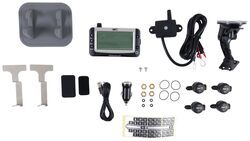
Easiest to Install/Use Tire Pressure Monitoring System for Trailer Application
Question:
Hello, I am really confused about all of the TPMS Tire Minder information out there. We are getting new Sailun 14 ply tires installed to replace westlake 235/80/16 that say 110 psi but also say G load range which I cannot find anything online referring to this tire being 14 ply or a G load rating with 110 psi. My husband swears it is fine to run 80psi in these westlake tires, thankfully we have only traveled about 3000, miles so far, with that psi, then staying parked for 5 months at a time, now getting ready to travel for our first long haul this winter. I have researched until i am blue in the face, trying to find all of the safety factors, about to low or to high psi. I am grateful to ETrailer for all of your great information, so that I can now know what the dangers of low/high psi can do. So the new tires will have the metal stems, we tow with a shortbed Ram 3500 dually diesel if that helps. Please let us know the best TPMS system for beginners. I will probably be installing these myself since my husband doesn’t take psi seriously, so as a senior woman i need all of the guidance and help I can get. I will be learning how to check the air pressure myself also. TIA
asked by: Sandie
Helpful Expert Reply:
The tire pressure monitoring system I would recommend for a "beginner" or anyone looking for the easiest to setup and easiest to use in general is the TST TPMS part # TST-507-FT-4. The reason I recommend it is because it installs easier by attaching to the valve stems (others mount in the tire), it's a flow through design which means you can inflate/deflate the tires without removing the sensors, and because it has a grayscale display instead of color which helps with the cost.
If you liked the idea of a color screen you'd want the # TST-507-FT-4-C instead.
You mentioned tire pressure which I wanted to mention also that with trailer tires you have to run the max pressure listed on the sidewall of the tire at all times. So what you do is inflate the tires (when cold) to the max rating PSI and you'll have the full tire weight capacity as well as minimize chance failure due to overheating.

Products Referenced in This Question
TST TPMS for RVs - Color Display - Signal Booster - 4 Flow Through Tire Sensors
- TPMS Sensor
- RV
- Trailer
- Mounts to Valve Stems
- 4 Sensors
- Flow Through Sensors
- Water Resistant
- Monitor Display
- TST
more information >
Product Page this Question was Asked From
TST TPMS for RVs - Grayscale Display - Signal Booster - 4 Flow Through Tire Sensors
- TPMS Sensor
- RV
- Trailer
- Mounts to Valve Stems
- 4 Sensors
- Flow Through Sensors
- Water Resistant
- Monitor Display
- TST
more information >
Featured Help Information
Instructions

Continue Researching
- Shop: TST TPMS for RVs - Color Display - Signal Booster - 4 Flow Through Tire Sensors
- Search Results: tpms
- Shop: TST TPMS for RVs - Grayscale Display - Signal Booster - 4 Flow Through Tire Sensors
- Shop: TireMinder i10 TPMS for RVs and Trailers w/ Signal Booster - 10 Tire Sensors
- Video: Review of TireMinder TPMS Sensor - 10 Tire Pressure Monitors Kit - TM56FR
- Shop: TireMinder i10 TPMS for RVs and Trailers w/ Signal Booster - 4 Tire Sensors
- Shop: TireMinder A1AS TPMS for RVs and Trailers w/ Signal Booster - Bluetooth - 10 Tire Sensors
- Shop: NOCO 12V Plug with HD Battery Clamps - 24" Long
- Shop: RV Covers
- Shop: Suspension Enhancement
- Search Results: f150 roof rack
- Shop: Rhino-Rack Vortex Aero Crossbars - Aluminum - Silver - 59" Long - Qty 2
- Shop: Roof Rack
- Video: Rhino-Rack Vortex Aero Roof Rack Review - 2006 Ford F-150
- Video: Rhino Rack Roof Rack Review - 2018 Ford F-150
- Search Results: tst~507~ft~4~c
- Video: Review of TST Tire Inflation and Repair - TPMS - TST-507-FT-4-C
- Q&A: Are SeeLevel Sensors 710-AR & 710-ES2 Available
- Shop: Towing Mirrors
- Search Results: 12 volt wire connectors
- Search Results: tst~507~r
- Search Results: 12v power accessories
- Search Results: rv water pump
- Q&A: Will TST TPMS for RVs TST-507-FT-4 Work Correctly With Rubber Valve Stems?
- Article: Which Sway Control Hitch is Right For Your Trailer?
- Shop: Windshield Covers
- Article: 7 Common Questions Everyone Has About Trailer Tires
- Q&A: Does Booster of TST TPMS for RVs # TST-507-FT-4-C Have to be Installed to Function
- Video: TST Color Display RV TPMS with Flow Through Tire Sensors Review
- Shop: Wheel Cover






